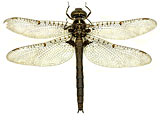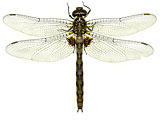
Northeastern DSA meeting in Sussex Co., New Jersey, June 22 - 24, 2007
Being relatively close to home and an area I've visited before, I only had a handful of species I was targeting for the NE DSA meeting in the northwest corner of New Jersey. Meetings have advantages and disadvantages for finding dragonflies. The trip leaders know the area and have species and locations staked out. Permission to get onto restricted or private properties have been arranged. With a couple of dozen people covering any given site, almost every dragonfly gets seen. However not everyone gets to see every good dragonfly. Another dynamic is some people like myself will swing the net first, while others would rather lift their binoculars or angle to get a photograph.
I drove to the Paulins Kill along the way to the meeting but after a couple of hours did not see anything exciting. I continued to the Delaware Water Gap and a field where I had seen one of my targets in the past, Septima's Clubtail, Gomphus septima. I had collected the species earlier this year in Alabama but the ones found in the Northeast are septima delawarensis, a disjunct population. I wanted to see what the differences are. But late in the day the field was quiet. I was content to collect a couple of female Rusty Snaketails, Ophiogomphus rupinsulensis, which were common but there was little else. I ducked into the car while a thunderstorm rumbled east crossing the river. I waited for the sun to come out again but it couldn''t entice any Septima's into the field. I never did see any all weekend.
The meeting officially began the next morning, catching up with familiar faces and meeting a few new ones. The group was divided in two, one group to head to the Delaware for big river odes, the other heading into Stokes State Forest for stream species. I joined the latter and followed our leader Jim Bangma into the field. Our first stop was a field owned by the Nature Conservancy. Wind swept the hillside and the sun played hide and seek behind puffy cumulus clouds. But there were several species of dragonfly foraging. Snaketails were high on my list and Nick Donnelly caught a female Brook, Ophiogomphus aspersus which he graciously let me scan that evening. Thanks Nick!
I was not so lucky with another snaketail I was hoping for. After stopping for lunch, I got stuck in traffic and fell behind the caravan. We arrived late at a stream crossing and was told we just missed a female Riffle Snaketail, Ophiogomphus carolus. Found by the parking area, it had been netted but then set on the ground for posed photographs. Despite a net hovering nearby, she got away. I sure hope someone got some good pictures.
At the same stream, a female Sable Clubtail, Gomphus rogersi, was caught. There was talk of posing her too but Jim Bangma knew I needed a specimen for the book and made sure I received it. Thanks Jim! This is a species I saw during my last trip to Georgia but weather had prevented me from finding a female. Later a couple of males were spotted along the stream providing some good field photo opportunities.
At the picnic that evening, a trip was proposed to look for Umber Shadowdragon, Neurocordulia obsoleta on the nearby Paulins Kill. Quite a few of us enthusiastically agreed to go despite the continuing wind and the evening's drop in temperature. But by the river the wind died down and it felt warm when a dragonfly flew by. Another circled out of reach, a female laying eggs. Most of us sat teetering on a large rock and the water's edge. The water was deep so wading was not practical here. A couple of people headed down the river to look for other access points.
Another shadowdragon skimmed by the rock and Jim Johnson sitting next to me deftly netted her. A few minutes later, he flicked another one off the surface of the water, another female. Now I was getting a little antsy. The guys that headed to find another access point came back to show off a male in the net and then, just minutes later, two more males, prompting some to abandon our rock to check out the other site. I doggedly decided to stay now that there was a little more room. It had gotten pretty dark when a dragonfly began to circle the black water just below my feet. It's flight was so erratic I could hardly follow it in the gloom. In desperation I slapped the net straight down into the water and was rewarded by a slightly wet but beautiful female Umber Shadowdragon.
I had hoped that I would be able to scan one of the captured males but they were to be posed the next day for photographs and then released. It was frustrating since I needed male scans but since I didn't catch them I couldn't really complain.
The next day I tried the points along the Delaware River with Allen Barlow leading. Allen had helped me a great deal with Damselflies of the Northeast so it was nice to catch up a little with him. We started in a field along the Delaware, the same spot I had visited on the way out. We found more species, most warming up in the morning sun. Spine-crowned Clubtails, Gomphus abbreviatus, were fairly common. There were a few Mustached Clubtails, Gomphus adelphus, along the edge of the field but the female I needed flew up and away. I caught a male Rapids Clubtail, Gomphus quadricolor. Allen and I almost convinced ourselves and everyone else it was a Green-faced Clubtail, Gomphus viridifrons, a species rare in the area. Later an real Green-faced Clubtail male was caught and Allen made sure I got the specimen for the book. Thanks Allen!
Also along the edge of the field a female Stygian Shadowdragon, Neurocordulia yamaskenensis was found perched low in a tree. This was another of my target species. The dragonfly's finder started taking pictures, then more photographers moved in. I was close enough to see her whirling her wings to warm up her wing muscles so I knew she wanted to get out of there. But with all the photographers snapping away I had to refrain from jumping in with the net so I turned my back and walked away. It didn't surprise me to hear a few seconds later, "There she goes!" as she flew from sight. As we gathered by the cars to move on to the next site, I heard a couple of people expressing disappointment that they had missed seeing the shadowdragon which wouldn't have been a problem had I netted it. Oh well, later that evening some of us would return to the Delaware and try to catch a few Stygians during their dusk flight.
But it had gotten even cooler that night and standing knee-deep in the river I only saw one shadowdragon flit by. The only one anyone caught that evening took three men to catch. Fred Sibley tried out a mist net which was held horizontally over the water by two people. When a dragonfly flew underneath, the plan was to drop the net down onto the surface of the water. The third person had to fish the dragonfly out from under the net. I think the method has a lot a promise. But it took a extraordinary effort to catch one female Stygian that night when a flick of the net would have resulted in the same catch earlier that day. But I guess it wouldn't have been half as fun.
I did get to scan that female that Fred and company caught. Thanks Fred! Oh and remember those three male Umber Shadowdragons that were slated for release? Well, one died in custody, so I got to scan that one too.



